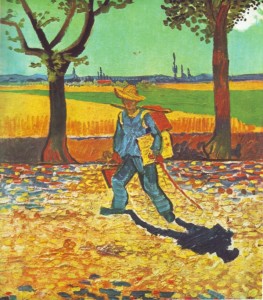By Lida Prypchan
 The Vincent van Gogh of the mid 1880s would, for most, be completely unrecognizable as the artist of popular repute. To date, he embraced somber, dark colors and refused the commercially viable style of the era’s Impressionist artists. But, van Gogh believed in his work. His subjects gave him the sort of material he seemed to crave, and controversy was no stranger.
The Vincent van Gogh of the mid 1880s would, for most, be completely unrecognizable as the artist of popular repute. To date, he embraced somber, dark colors and refused the commercially viable style of the era’s Impressionist artists. But, van Gogh believed in his work. His subjects gave him the sort of material he seemed to crave, and controversy was no stranger.
At least temporarily in late 1885, Vincent found himself without subjects to paint. During the earlier half of that decade, Vincent painted advantageous portraits of character studies known as the Peasant Character Studies. Working men and women, consisting of laborers such as farmers, weavers, and fishermen, were van Gogh’s preferred models. And, in the light of the “peasant genre,” van Gogh prodigiously produced hundreds of oil paintings of his subjects much in the style of noted artist, Jean-Francois Millet. The difference between the two is that Millet’s work featured lighting that van Gogh preferred to dim.
But in September of 1885, it is rumored that one of his female subjects became pregnant with his child. The young woman, Gordina de Groot, who had appeared in The Potato Eaters, claimed that the child was not Vincent’s, but the village priest prevented those residing in the village from posing for Vincent from then on. Still, with a need to paint, Vincent switched his focus to still life compositions.
Perhaps looking for inspiration, Vincent moved to Antwerp, Belgium in November of that same year. Not one to waste his meager allowance from his brother, Theo, on anything other than painting supplies, Vincent grew ill as the winter progressed. He spent his time wandering the local museums and subsisting on bread, coffee, and tobacco, as well as absinthe, a strong alcoholic beverage, highlighted by some as highly addictive and psychoactive. This unhealthy combination likely led to Vincent’s dental issues (his teeth became loose and painful) and his lack of appetite.
Although ill, Vincent worked toward an education in painting and drawing at the Academy of Fine Arts in Antwerp throughout the winter. By February of 1886, Vincent was in poor physical shape but expanding his outlook on his work.
While he was in Antwerp, van Gogh began to explore the use of color, and he studied color theory. Attracted to Japanese Ukiyo-e woodcuts, Vincent now incorporated colors such as carmine, cobalt, and emerald green into his repertoire. Vincent used the term “Japonaiserie” to describe the influence this new color palette had on his work. And in true van Gogh fashion, he dedicated himself to the style.
Leaving Antwerp for Paris and the company of his brother, Theo. While there, both Vincent and Theo invested in the inexpensive Ukiyo-e woodcuts and Vincent’s emotional health seemed to improve – at least for the time being. He and Theo collected and sold many woodcut prints, and the color presented in his work appeared to lift his spirits. After all, said Vincent, “… we wouldn’t be able to study Japanese art, it seems to me, without becoming much happier and more cheerful, and it makes us return to nature, despite our education and our work in a world of convention.”
